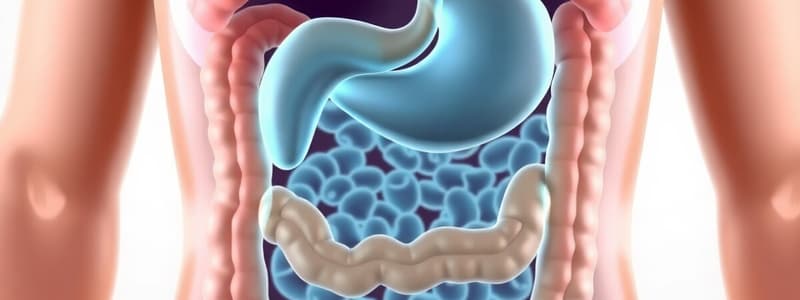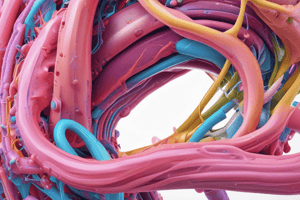Podcast
Questions and Answers
What is the primary function of the large intestine in the digestive process?
What is the primary function of the large intestine in the digestive process?
- Absorb nutrients into the blood.
- Produce digestive enzymes for nutrient breakdown.
- Form and concentrate waste into feces. (correct)
- Digest carbohydrates for energy.
Which of the following correctly describes the role of the visceral peritoneum?
Which of the following correctly describes the role of the visceral peritoneum?
- Anchors the abdominal wall.
- Facilitates water absorption.
- Covers the inner cavity wall.
- Protects and supports the organs. (correct)
What is a key feature of bacterial action in the large intestine?
What is a key feature of bacterial action in the large intestine?
- Fermentation of undigested carbohydrates. (correct)
- Synthesis of essential fatty acids.
- Digestion of proteins.
- Absorption of all minerals.
Which statement best describes intraperitoneal organs?
Which statement best describes intraperitoneal organs?
What is the primary function of serous fluid within the peritoneal cavity?
What is the primary function of serous fluid within the peritoneal cavity?
Which component of the digestive system plays a critical role in excretion?
Which component of the digestive system plays a critical role in excretion?
What is the significance of mesenteries in the abdominal cavity?
What is the significance of mesenteries in the abdominal cavity?
What type of epithelium transitions from the rectum to the anus?
What type of epithelium transitions from the rectum to the anus?
Which digestive sphincter is responsible for preventing backflow into the small intestine?
Which digestive sphincter is responsible for preventing backflow into the small intestine?
Which is NOT a function of the liver?
Which is NOT a function of the liver?
What primary role does the external anal sphincter serve?
What primary role does the external anal sphincter serve?
Which of the following organs is NOT classified as retroperitoneal?
Which of the following organs is NOT classified as retroperitoneal?
Which component is NOT part of the portal triad in the liver?
Which component is NOT part of the portal triad in the liver?
What is the primary function of the muscular layer of the digestive tract?
What is the primary function of the muscular layer of the digestive tract?
Which structure is responsible for coordinating peristaltic contractions in the digestive tract?
Which structure is responsible for coordinating peristaltic contractions in the digestive tract?
What type of tissue primarily composes the submucosa of the digestive tract?
What type of tissue primarily composes the submucosa of the digestive tract?
Which organ is considered the first part of the small intestine?
Which organ is considered the first part of the small intestine?
Which layer of the digestive tract provides anchorage and protection?
Which layer of the digestive tract provides anchorage and protection?
What are the major components found in the submucosa?
What are the major components found in the submucosa?
Which part of the colon is classified as retroperitoneal?
Which part of the colon is classified as retroperitoneal?
What type of muscle is primarily found in the muscular layer of the digestive tract?
What type of muscle is primarily found in the muscular layer of the digestive tract?
What is the primary function of the mucosa in the digestive tract?
What is the primary function of the mucosa in the digestive tract?
Which type of epithelium primarily lines the oral cavity to protect against abrasion?
Which type of epithelium primarily lines the oral cavity to protect against abrasion?
How does parasympathetic stimulation affect saliva production?
How does parasympathetic stimulation affect saliva production?
Which type of cells in the stomach are responsible for secreting hydrochloric acid (HCl)?
Which type of cells in the stomach are responsible for secreting hydrochloric acid (HCl)?
What characteristic distinguishes the parotid gland from other salivary glands?
What characteristic distinguishes the parotid gland from other salivary glands?
What is the primary function of the jejunum within the small intestine?
What is the primary function of the jejunum within the small intestine?
Which region of the pharynx is lined with respiratory epithelium?
Which region of the pharynx is lined with respiratory epithelium?
In the large intestine, which structure is responsible for creating sac-like formations known as haustra?
In the large intestine, which structure is responsible for creating sac-like formations known as haustra?
What transition occurs in the muscular layers of the esophagus?
What transition occurs in the muscular layers of the esophagus?
Which type of epithelial cell in the small intestine is specialized for absorption and has microvilli?
Which type of epithelial cell in the small intestine is specialized for absorption and has microvilli?
What is the composition of the lamina propria in the mucosa?
What is the composition of the lamina propria in the mucosa?
What type of saliva does the submandibular gland primarily produce?
What type of saliva does the submandibular gland primarily produce?
What is the role of enteroendocrine cells found in the stomach?
What is the role of enteroendocrine cells found in the stomach?
What type of epithelial tissue is found in the oropharynx and laryngopharynx?
What type of epithelial tissue is found in the oropharynx and laryngopharynx?
Which layer of muscle in the stomach is NOT part of the muscular layers responsible for mixing food?
Which layer of muscle in the stomach is NOT part of the muscular layers responsible for mixing food?
What unique feature distinguishes the large intestine from the small intestine histologically?
What unique feature distinguishes the large intestine from the small intestine histologically?
Which of the following statements about the adventitia of the esophagus is correct?
Which of the following statements about the adventitia of the esophagus is correct?
What type of cells in the large intestine are primarily responsible for mucus secretion?
What type of cells in the large intestine are primarily responsible for mucus secretion?
Which segment of the small intestine is the longest?
Which segment of the small intestine is the longest?
What is primarily absorbed in the large intestine?
What is primarily absorbed in the large intestine?
Flashcards
Nutrient Transport
Nutrient Transport
The process of moving nutrients from the digestive tract into the bloodstream and lymphatic system.
Passive Transport
Passive Transport
A passive process that moves substances across cell membranes from an area of high concentration to an area of low concentration. No energy is required.
Active Transport
Active Transport
An active process that moves substances across cell membranes from an area of low concentration to an area of high concentration. This process requires energy.
Compaction in Digestion
Compaction in Digestion
Signup and view all the flashcards
Excretion in Digestion
Excretion in Digestion
Signup and view all the flashcards
Peritoneum
Peritoneum
Signup and view all the flashcards
Intraperitoneal Organs
Intraperitoneal Organs
Signup and view all the flashcards
Serosa (or Adventitia)
Serosa (or Adventitia)
Signup and view all the flashcards
Muscular Layer
Muscular Layer
Signup and view all the flashcards
Submucosa
Submucosa
Signup and view all the flashcards
Mucosa
Mucosa
Signup and view all the flashcards
Peristalsis
Peristalsis
Signup and view all the flashcards
Myenteric Plexus
Myenteric Plexus
Signup and view all the flashcards
Submucosal Plexus (Meissner's Plexus)
Submucosal Plexus (Meissner's Plexus)
Signup and view all the flashcards
What is the mucosa?
What is the mucosa?
Signup and view all the flashcards
What type of epithelium is found in the mucosa?
What type of epithelium is found in the mucosa?
Signup and view all the flashcards
What is the lamina propria?
What is the lamina propria?
Signup and view all the flashcards
What is the muscularis mucosae?
What is the muscularis mucosae?
Signup and view all the flashcards
What is ingestion?
What is ingestion?
Signup and view all the flashcards
What is mechanical digestion?
What is mechanical digestion?
Signup and view all the flashcards
What is chemical digestion?
What is chemical digestion?
Signup and view all the flashcards
What are the types of salivary glands and their secretions?
What are the types of salivary glands and their secretions?
Signup and view all the flashcards
What is the function of the pharynx?
What is the function of the pharynx?
Signup and view all the flashcards
What is the function of the esophagus?
What is the function of the esophagus?
Signup and view all the flashcards
Pyloric Sphincter
Pyloric Sphincter
Signup and view all the flashcards
Liver
Liver
Signup and view all the flashcards
Bile
Bile
Signup and view all the flashcards
Gallbladder
Gallbladder
Signup and view all the flashcards
Hepatocytes
Hepatocytes
Signup and view all the flashcards
Digestion
Digestion
Signup and view all the flashcards
Absorption
Absorption
Signup and view all the flashcards
Motility
Motility
Signup and view all the flashcards
Rugae
Rugae
Signup and view all the flashcards
Muscle Layers in the Stomach
Muscle Layers in the Stomach
Signup and view all the flashcards
Duodenum
Duodenum
Signup and view all the flashcards
Jejunum
Jejunum
Signup and view all the flashcards
Peyer's Patches
Peyer's Patches
Signup and view all the flashcards
Study Notes
Learning Outcomes - Digestive System
- Recall the functions of each digestive organ and its key features
- Define peristalsis and segmentation
- Identify the layers of the peritoneum and their function
- Differentiate between intraperitoneal and retroperitoneal organs with examples
- Describe the layers of the digestive tract with a focus on their histological organization
- Detail the structure and function of salivary glands and digestive sphincters
- List the key cells in the stomach and small intestine mucosa
- Discuss the liver, gallbladder and pancreas, and link their components to their function
- Explain the role of the hepatic portal vein
- Relate bile production to digestive function in the small intestine and storage
Functions of the Digestive Tract
- Ingestion: Intake of food into the mouth
- Organ: Mouth
- Features: Teeth, salivary glands
- Mechanical Processing: Breakdown of food mechanically
- Organ: Mouth
- Features: Teeth grinding, tongue mixing with saliva
- Chemical Processing: Breakdown of food chemically
- Organ: Mouth
- Features: Saliva containing enzymes for carbohydrate digestion (e.g., amylase)
- Digestion: Breakdown of food into absorbable molecules
- Organ: Stomach
- Features: Gastric glands secrete digestive enzymes (pepsin) and hydrochloric acid (HCl)
- Significant Features: Gastric glands secrete digestive enzymes (pepsin) and hydrochloric acid (HCl).
Studying That Suits You
Use AI to generate personalized quizzes and flashcards to suit your learning preferences.




